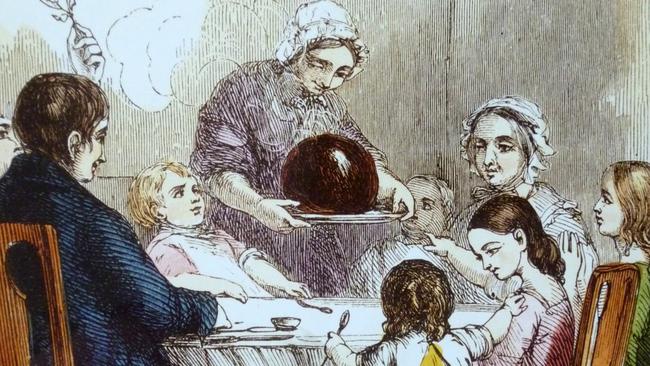Pudding tradition first at the Christmas dinner table
There are festive treats only eaten or imbibed at Christmas time. The reasons for their festive associations are many and varied

Today in History
Don't miss out on the headlines from Today in History. Followed categories will be added to My News.
Christmas is a time for gathering family and friends together and, after observing the spiritual significance of the season, to sit down and feast. While the modern Australian Christmas feast often features whatever food is favoured by those who prepare it, sampling the best the summer season has to offer, we hang on to some traditional elements that have carried over from cold weather European Christmases.
Many of these do not appear at any other time of year.
One is the fruit mince pie. This strange concoction of shortbread pastry filled with minced fruits, usually soaked in alcohol, is served up only at yuletide feasts.
There are several theories on its origin, including one which suggests some kinship to the spiced fruit pastries made in the Middle East. Crusaders who sampled these treats returned to Europe and had their chefs create versions more fitting European palates, which diluted the richness of the spiced fruit with suet and meat. The European pies were also larger than the Levantine titbits.
Over the centuries as Europe developed more of a taste for rich, fruity treats the meat was dispensed with and small fruit-filled mince pies became part of the Christmas feast.
This may have been because the pies were associated with the Holy Land, or perhaps because the fruits preserved by drying out in summer were saved for winter when there was less fresh fruit available.
There is also a theory that the three kinds of spices used — cloves, cinnamon and nutmeg — represented the three gifts given to the infant Jesus. By the 17th century the pies were a regular fixture on English Christmas tables and even rated several mentions in the diaries of Samuel Pepys.
Dried fruit also forms a major part of the Christmas pudding, sometimes known as a “plum pudding” even if it isn’t actually made with plums. The name comes from the fact that the pudding evolved from a sloppy, porridge like dish called plum pottage.
Plum pottage, or plum broth, was made with varying amounts of liquid which usually included brandy or other alcohol, along with meat, spices and fruit. This was a perfect winter dish, but at Christmas cooks produced a special version with prunes, dried plums, hence the name plum pottage.
The pottage was often thickened with breadcrumbs but in times of little meat more fruit and more flour were added to thicken it. While pottage didn’t disappear altogether, some people preferred a more solid version and cooked fruity, floury concoctions (still made with suet) in offal bags then later in cloth bags, giving them the rounded shape. The puddings were popular by the 19th century and writers such as Charles Dickens considered them a central part of the feast, a venerable tradition.
The tradition was carried to Australia where it was often debated whether to continue the practice of eating a hot pudding in the heat of an Australian summer.
Most Australians clung tenaciously to the tradition, despite the temperatures created in furnace-like kitchens. The compromise was often to eat the pudding cold or served with cream or cold custard.
In the early years of colonisation currants, plums and other ingredients were imported from England. There are stories of diggers cooking up puddings in their tents on the goldfields. In World War I and II special provisions were made to ensure our soldier diggers had puddings at the front for Christmas.
While over the years many people have washed down their pudding with what they thought was the traditional English eggnog, it seems likely that this rum, egg, milk and spice concoction is something we owe partly to the Americans.
Eggnog probably originated with a medieval drink called “posset”, a mixture of milk, alcohol and spices that was usually imbibed by monks in the cold weather. Somewhere along the way eggs were added to this cocktail (probably for extra nutritional content) and it was named eggnog after noggin, a word for either a cup used to serve ale or for the ale itself.
The mixture of eggs with brandy or fortified wine was expensive, which made it a drink for the wealthy in England, but in the American colonies an abundance of rum and eggs made it a cheaper drink for ordinary people. However, it was swilled mostly on festive occasions, particularly Christmas.
This custom came to Australia by way of American whalers and gold miners, but with a variation in that we usually prefer our eggnog cold.
troy.lennon@news.com


